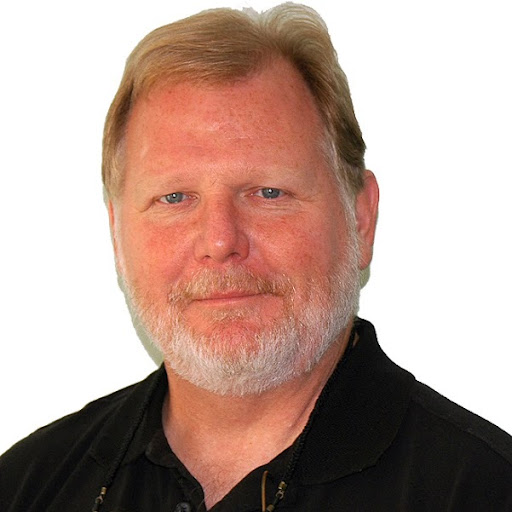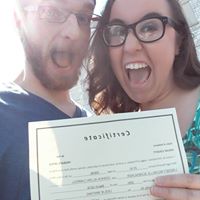Allen M Carroll
age ~76
from San Jose, CA
- Also known as:
-
- Allen Maury Carroll
- Allen Maury Te Carroll
- Allen Diana Carroll
- Allan Carroll
- Phone and address:
-
26 Ryland Park Dr, San Jose, CA 95110
4089471311
Allen Carroll Phones & Addresses
- 26 Ryland Park Dr, San Jose, CA 95110 • 4089471311
- Merced, CA
- 720 Calmar Ave, Oakland, CA 94610
- Brooklyn, NY
- Napa, CA
- Berkeley, CA
- Ithaca, NY
Us Patents
-
Border Modification For Proximity Effect Correction In Lithography
view source -
US Patent:6436607, Aug 20, 2002
-
Filed:Mar 2, 2000
-
Appl. No.:09/517612
-
Inventors:Richard L. Lozes - Pleasanton CA
Andrew Muray - Portland OR
Allen M. Carroll - Oakland CA -
Assignee:Applied Materials, Inc. - Santa Clara CA
-
International Classification:G03C 500
-
US Classification:430296, 25049222
-
Abstract:Dose conservation is used during pattern modification in the data preparation phase of scanning beam lithography. The features to be exposed on a substrate, such as a mask or direct written semiconductor wafer, are corrected while neighboring features suffer little or no change. Thus, the edge of a feature is moved in terms of its exposure location without appreciably affecting the scattering into its neighbors. This achieves a developed feature which meets the intended design edge location. This process also corrects for variations in resist profile angles which otherwise may vary depending upon localized feature packing density. Not only is the feature edge moved but its dose per area is adjusted while conserving total dose over the feature.
-
Electron Beam Lithography Method And Apparatus Using A Dynamically Controlled Photocathode
view source -
US Patent:7696498, Apr 13, 2010
-
Filed:Mar 15, 2007
-
Appl. No.:11/686905
-
Inventors:Allen M. Carroll - San Jose CA, US
-
Assignee:KLA-Tencor Technologies Corporation - Milpitas CA
-
International Classification:G01J 3/10
-
US Classification:25049222, 250396 R, 25049223, 250397, 2504923
-
Abstract:Embodiments of the invention include an electron beam lithography device using a dynamically controllable photocathode capable of producing a patterned electron beam. One such implementation includes a dynamic pattern generator configurable to produce an electron beam having a desired image pattern impressed thereon. Such an electron beam pattern being enabled by selectively activating programmable photoemissive elements of the pattern generator. The apparatus further including an illumination source arranged to direct a light beam onto the dynamic pattern generator to produce the electron beam having the desired pattern. The electron beam being directed through associated electron optics configured to receive the electron beam from the dynamic pattern generator and direct the electron beam onto a target substrate mounted on a stage.
-
Electron Beam Patterning
view source -
US Patent:7958464, Jun 7, 2011
-
Filed:Aug 28, 2008
-
Appl. No.:12/199922
-
Inventors:Luca Grella - Gilroy CA, US
Allen M. Carroll - San Jose CA, US -
Assignee:KLA-Tencor Corporation - Milpitas CA
-
International Classification:G06F 17/50
-
US Classification:716 55
-
Abstract:A method for creating an electron beam pattern exposure, where a pattern of shapes is generated, including at least one of lines and vias. To each shape there is assigned a set of exposure pixels and edge placement constraints. An intensity at each exposure pixel is calculated by using a simplex method, and a latent resist image location is calculated by convolving a proximity function with the pixel intensities. A shape critical dimension and a shape edge slope is statistically evaluated by applying linear regression on the locations of the calculated latent image. The electron beam pattern exposures are produced using dosages linearly optimized on a rotated pixel grid to produce the shape critical dimension and the shape edge slope.
-
Quasi-Annular Reflective Electron Patterning Device
view source -
US Patent:8373144, Feb 12, 2013
-
Filed:Aug 31, 2010
-
Appl. No.:12/873158
-
Inventors:Mark A. McCord - Los Gatos CA, US
Paul F. Petric - Pleasanton CA, US
Allen Carroll - San Jose CA, US -
Assignee:KLA-Tencor Corporation - Milpitas CA
-
International Classification:G21K 1/02
-
US Classification:25049222, 250396 R, 250398, 2504921, 25049223, 2504923
-
Abstract:One embodiment relates to an electron-beam apparatus for writing a pattern on a target substrate. The apparatus includes a plurality of arrays of actively-controlled pixel elements at a surface of a reflective electron patterning device. The plurality of arrays of actively-controlled pixel elements are arranged so that there is an area without any actively-controlled pixel elements in a region surrounding an optical axis of the objective lens. The plurality of arrays may be arranged to each lie on a circle centered on the optical axis. Other features, aspects and embodiments are also disclosed.
-
Apparatus And Methods For Pattern Generation
view source -
US Patent:20120085919, Apr 12, 2012
-
Filed:Oct 8, 2010
-
Appl. No.:12/901217
-
Inventors:Shinichi KOJIMA - Cupertino CA, US
Christopher F. BEVIS - Los Gatos CA, US
Allen M. CARROLL - San Jose CA, US -
International Classification:H01J 3/14
-
US Classification:250396 R
-
Abstract:One embodiment relates to an apparatus for writing a pattern on a target substrate. The apparatus includes a plurality of arrays of pixel elements, each array being offset from the other arrays. In addition, the apparatus includes a source and lenses for generating an incident beam that is focused onto the plurality of arrays, and circuitry to control the pixel elements of each array to selectively reflect pixel portions of the incident beam to form a patterned beam. The apparatus further includes a projector for projecting the patterned beam onto the target substrate. Other features, aspects and embodiments are also disclosed.
-
Pattern Data System For High-Performance Maskless Electron Beam Lithography
view source -
US Patent:20130205267, Aug 8, 2013
-
Filed:Jan 30, 2013
-
Appl. No.:13/754760
-
Inventors:Allen CARROLL - San Jose CA, US
-
Assignee:KLA-TENCOR CORPORATION - Milpitas CA
-
International Classification:G06F 17/50
-
US Classification:716 55
-
Abstract:One embodiment relates to a pattern data system for maskless electron beam lithography. The system includes a renderer that receives pre-exposure die image data, performs rendering of the pre-exposure die image data to generate raster data. The system further includes a plurality of data distributors communicatively coupled to the renderer. Each data distributor adapts the raster data to characteristics of an associated pattern writer. Other embodiments, aspects and feature are also disclosed.
-
Specimen Distance Measuring System
view source -
US Patent:47884312, Nov 29, 1988
-
Filed:Apr 10, 1987
-
Appl. No.:7/036731
-
Inventors:William A. Eckes - Hayward CA
Lee Veneklasen - Castro Valley CA
Glen E. Howard - Pleasanton CA
Donald J. McCarthy - Hayward CA
Allen M. Carroll - Oakland CA
Daniel L. Cavan - Woodside CA -
Assignee:The Perkin-Elmer Corporation - Norwalk CT
-
International Classification:H01J 37244
-
US Classification:250397
-
Abstract:A specimen distance measuring system uses a plate (36) to obstruct the flux of backscattered electrons produced by an electron beam (18), and to cast a shadow across a measurement detector (32) which is sensitive to the position of the shadow. The shadow plate (36) and measurement detector (32) are aligned at an angle of approximately 45 degrees with a substrate (14) in order to allow calibration of the distance measuring system by scanning the electron beam (18). The measuring system is particularly useful as a height sensor (10) in an electron beam lithography apparatus (12) for sensing the height of a substrate (14). The distance measuring system may also include a reference detector (34) which is positioned in order to receive backscattered electron flux without obstruction from the shadow plate (36). The use of such a reference detector (32) is advantageous in allowing compensation of the signals obtained by the measurement detector, in order to allow the height sensor to operate independently of variations in electron beam current, and variations in substrate backscatter coefficient. The reference and measurement detectors (34,32) may be aligned in a vertical or horizontal plane to be either parallel to or perpendicular to the bombardment electron beam (18).
-
Virtual Addressing For E-Beam Lithography
view source -
US Patent:44980108, Feb 5, 1985
-
Filed:May 5, 1983
-
Appl. No.:6/491678
-
Inventors:Charles S. Biechler - Hayward CA
Allen M. Carroll - Berkeley CA
Richard E. Graves - Fremont CA
Steven A. Lyons - Oakland CA -
Assignee:The Perkin-Elmer Corporation - Norwalk CT
-
International Classification:H01J 37302
H01J 37317 -
US Classification:2504922
-
Abstract:A technique performed in a fixed address particle beam lithographic system where the writing is performed in the normal manner for writing a pattern, for example, a stripe on a resist having a selected feature width except that an additional row of alternate pixels is written either before or after the selected feature is written. The alternate pixels, when the resist is developed, will provide a feature width of approximately 1/2 a pixel wider than the selected feature width due to blurring of the latent image caused by scattering of the particle beam within the resist. Thus, the resolution of selectable feature widths is enhanced with little or no loss of throughput. The same technique can also be utilized to lengthen a feature by 1/2 a pixel width. The technique is disclosed primarily in a raster scan machine but also disclosed is the technique in a vector scan machine. Also disclosed is a flow chart showing the invention used while preparing the data to be written by the machine.
Name / Title
Company / Classification
Phones & Addresses
CEO Bon Secours St.
Roper St. Francis Healhcare
Hospitals
Hospitals
125 Doughty Street, Suite 760, Charleston, SC 29403
8437242915, 8437208355
8437242915, 8437208355
President
LOGICLAB, INC
720 Calmar Ave, Oakland, CA 94610
Resumes

Climate Studies
view sourceLocation:
San Francisco, CA
Industry:
Semiconductors
Work:
Pdf Solutions Jul 2016 - Jul 2017
Principal Engineer
Taba Research Jul 2016 - Jul 2017
Climate Studies
Kla-Tencor Feb 2006 - Jul 2014
Director, Rebl Patterning Technology
Mycronic 2001 - 2004
Senior Scientist
Etec Systems Feb 1999 - Mar 2001
Systems Engineering Manager
Principal Engineer
Taba Research Jul 2016 - Jul 2017
Climate Studies
Kla-Tencor Feb 2006 - Jul 2014
Director, Rebl Patterning Technology
Mycronic 2001 - 2004
Senior Scientist
Etec Systems Feb 1999 - Mar 2001
Systems Engineering Manager
Education:
University of California, Berkeley, Haas School of Business 1991 - 1994
Master of Business Administration, Masters Cornell University 1970 - 1976
Doctorates, Doctor of Philosophy, Physics
Master of Business Administration, Masters Cornell University 1970 - 1976
Doctorates, Doctor of Philosophy, Physics
Skills:
Systems Design
Physics
Engineering Management
Systems Engineering
Sensors
Electronics
System Design
Data Processing
Solutions
Engineering
Software
Signal Processing
Embedded Systems
Pattern
Cross Functional Team Leadership
House
Simulations
Semiconductors
Product Development
Contractors
System Architecture
R&D
Hardware
Nanotechnology
Ic
Physics
Engineering Management
Systems Engineering
Sensors
Electronics
System Design
Data Processing
Solutions
Engineering
Software
Signal Processing
Embedded Systems
Pattern
Cross Functional Team Leadership
House
Simulations
Semiconductors
Product Development
Contractors
System Architecture
R&D
Hardware
Nanotechnology
Ic
Interests:
Human Rights
Science and Technology
Environment
Arts and Culture
Science and Technology
Environment
Arts and Culture

Allen Carroll
view source
Allen Carroll
view source
Allen Carroll
view source
Allen Carroll
view source
Allen Carroll
view source
Allen Carroll
view source
Allen Carroll
view sourceLocation:
United States
Googleplus

Allen Carroll

Allen Carroll

Allen Carroll
Work:
AD-Con-Co.com - Boss (2013)

Allen Carroll

Allen Carroll

Allen Carroll
Youtube
Myspace
Plaxo

Allen Carroll
view sourceAtlanta, GASales Manager at Applied Ceramics

Allen Carroll
view sourceKLA Tencor
Flickr
Classmates

Allen Carroll
view sourceSchools:
Trademark Learning Center Greeley CO 1998-2002
Community:
Julie Kirkpatrick, Claudia Garcia

Allen Carroll
view sourceSchools:
Central High School Superior WI 1948-1952
Community:
Joan Ciatti, Dolores Murray, Sandra White, Jim Johnson

Allen Carroll
view sourceSchools:
Dublin High School Dublin GA 1960-1964

Allen Carroll
view sourceSchools:
Franklin River School Port Alberni Saudi Arabia 1949-1953
Community:
Jamie Amos

Allen Carroll
view sourceSchools:
Wayne High School Wayne OK 1981-1985
Community:
Jolynn George, John Kiosterud, Angela Hobbs, Lynette Fisher

Allen Carroll
view sourceSchools:
Franklin River School Port Alberni Saudi Arabia 1955-1959, West Whalley High School Surrey Saudi Arabia 1959-1964
Community:
Wayne Egelstad, Joan Lundberg

Allen Carroll
view sourceSchools:
White Sulphur Springs High School White Sulphur Springs WV 1960-1964
Community:
Jerry Shelton, Robert Glover, Nancy Collins, Saundra Banfield, Margaret Garrett, Gene Sizemore, Barbara Owens, Gerald Wood, Jean O'farrell, Gary Fogus

Trademark Learning Center...
view sourceGraduates:
Allen Carroll (1998-2002),
Jorge Gutierrez (1999-2003)
Jorge Gutierrez (1999-2003)

Allen Carroll
view source
Matthew Allen Carroll
view source
Kim Allen Carroll
view source
Jo Allen Carroll
view source
Una Allen Carroll
view source
Allen Carroll
view source
Allen Carroll
view source
Joshua Allen Carroll
view sourceGet Report for Allen M Carroll from San Jose, CA, age ~76













